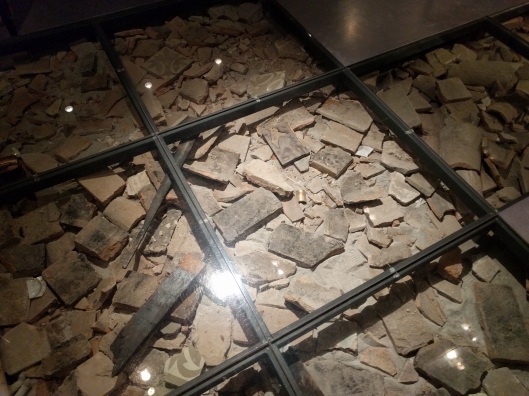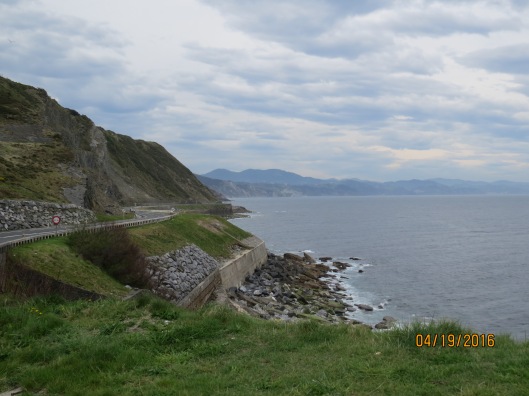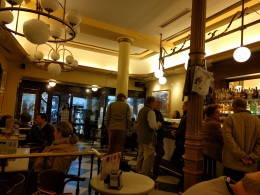About 14 years ago we spent a couple of weeks in Spain with much of our family. We visited Barcelona, Madrid, Valencia, Seville and the Costa del Sol. While we loved it all, it was very different from the Basque Country in northern Spain where we are now. In my mind this is the most beautiful part of the country. We took three days to drive from southern Portugal to where we are now in Zarautz, Spain. We took an engineering feat of a highway from Santiago de Compostela here. The highway was just completed last year the cost of which skyrocketed because of the typography of the area which makes for the most amazing scenery. The highway seems to hang over valleys running past windmills that sit atop the mountains. From there it turns down to the Cantabrian Sea only to reascend to the heights around the next curve. There are numerous tunnels just because there is no where else for the road to go.

 Basque country extends across northern Spain and southern France and many consider themselves Basque not Spanish or French.
Basque country extends across northern Spain and southern France and many consider themselves Basque not Spanish or French.  We didn’t realize before we came here that the Basques not only have their own culture but their own language as well. During Franco’s time in power the Basque language was not taught so generally people growing up between 1939 and the late 1970s know little Basque. But in the 1980s it had a resurgence. It’s a very difficult language with lots of tx’s and k’s and z’s. We have found little English spoken here but because the people are so very friendly and everyone speaks Spanish and my Spanish is improving with daily practice, we have been able to get along reasonably well.
We didn’t realize before we came here that the Basques not only have their own culture but their own language as well. During Franco’s time in power the Basque language was not taught so generally people growing up between 1939 and the late 1970s know little Basque. But in the 1980s it had a resurgence. It’s a very difficult language with lots of tx’s and k’s and z’s. We have found little English spoken here but because the people are so very friendly and everyone speaks Spanish and my Spanish is improving with daily practice, we have been able to get along reasonably well.
When we first arrived and met up with Daniel, our landlord for the month, he went above and beyond to introduce us to the area. Daniel is a surfer and explained to us the week before we arrived there were European surfing championships here. After showing us around the apartment, he drove with us into town pointing out a major supermarket (very Meijer-like for you Michiganders!) and also took us to a nearby taberna introducing us to the local specialty, Txokoli (pronounced choc o lee). It’s a dry sparkling wine that is poured from quite a height in order to enhance the fizziness of the drink.
Daniel is a surfer and explained to us the week before we arrived there were European surfing championships here. After showing us around the apartment, he drove with us into town pointing out a major supermarket (very Meijer-like for you Michiganders!) and also took us to a nearby taberna introducing us to the local specialty, Txokoli (pronounced choc o lee). It’s a dry sparkling wine that is poured from quite a height in order to enhance the fizziness of the drink. It’s really difficult for us to get used to the late dining hour of the Spanish. 8:30 is just too late for us to eat but they do have amazing tapas, called pintxos in Basque, that are very tasty and served for lunch until about 6 pm and very reasonable as well. A pintxo usually sells for between 1 euro and 1,65 (about $1.15 to $2)!
It’s really difficult for us to get used to the late dining hour of the Spanish. 8:30 is just too late for us to eat but they do have amazing tapas, called pintxos in Basque, that are very tasty and served for lunch until about 6 pm and very reasonable as well. A pintxo usually sells for between 1 euro and 1,65 (about $1.15 to $2)!

Pintxos
That combined with a beer or glass of wine means a delightful lunch for two can be had for less than $10. Like other places we’ve visited we feel fortunate to be here in the off season when the population is about 22,000 given that in the summer the population surges to about three times that. From our apartment we get a glimpse of the ocean. There’s a promenade that parallels the sea and provides a great place to stroll and stop for a pinxto or cerveza in the afternoon.

View from our bedroom

View from our balcony
Zarautz has been a great base for us as there are many nearby places for day trips. We have traveled to Basque France, specifically St. Jean de Luz, another beautiful seaside community, which is about a half hour drive from here.
We did notice that the French we met spoke mostly French and not Basque. Bob got a much needed hair cut while we were there, in a tiny shop, where the barber spoke absolutely no English. Utilizing a lot of hand motions he managed to get his hair trimmed as well as his beard. We’re getting the knack of this haircut communication sans words! We were a bit taken aback by the amount of security at the French border. While we were not stopped, there were many guards eyeing the traffic as it passed through. The car in front of us was stopped, but it had a Russian plate and we were thinking that perhaps they needed to show their visa. Returning to Spain we encountered no such security.
We were excited that the Italians had a long holiday weekend allowing Cary to visit us. She flew into Bilbao, about an hour west of us. After picking her up at the airport we visited the Guggenheim Museum designed by Frank Gehry.


 The architecture of the museum itself is as spectacular as the works it contains!
The architecture of the museum itself is as spectacular as the works it contains!
The town of Guernica is also really interesting. It’s more than 600 years old and founded at the intersection of two important roads where it is said that important discussions of the community were held underneath the Guernica Tree there.

The Guernica Tree
More recently, in 1937, with Franco’s permission, the Germans and Italians relentlessly bombed Guernica in support of Franco’s wanting to overthrow the Basques. According to Basque figures, more than 2500 people were killed. Picasso was commissioned to create a huge mural depicting the resulting suffering and chaos, considered by many to be his greatest work.

This is a copy. The actual mural is housed at the Museo Reina Sofia in Madrid.
It is interesting that Picasso would not let the picture hang in Spain until they became a Republic (and since Picasso died before Franco, the painting wasn’t returned to Spain until 1981, after Picasso’s death.) In the Museum of Peace in Guernica, we sat in a darkened room, a replication of a typical home of the time, listening to a recording describing the experience the residents were living through…complete with sounds of bombs in the background. All that remained after the bombing was the school house that is still there and still used (as well as The Guernica Tree). The floor of the museum is made from the debris of the devastation under glass! The experience haunted me for hours after.

The Peace Museum

Floor of museum made of the bombing debris

The School that survived
We also visited San Sebastian, which I believe is the prettiest city in the area. The Basque have done a wonderful job of integrating the old with the new, and the setting of mountains combined with sandy beaches is always gorgeous!

Square in San Sebastian

Along the San Sebastian Beach

My favorite San Sebastian sculpture: Don Quixote & Sancho Panza
Our apartment is extraordinarily reasonable but it doesn’t have wifi and I wasn’t quite sure how we would survive for a month without being connected, given that all we do on line. Daniel had pointed out a coffee shop/bakery/bar just a few meters from our apartment. We tried that for the first couple of days and were delighted when we met a delightful gentleman who asked where we were from in the US. (Many we have met, assume we are British because we speak English) but our new friend Juan had lived in Chicago so his English was exceptional and he was excited to talk about Chicago. The first thing he said to us was, “Welcome!” How very warm that made us feel! (A few days later we were eating pintxos in a local cafe and a woman asked if we were speaking French or English. When I responded English, she too said, “Welcome.” Made me think about all the non-Americans I have met in the US and I don’t know that I have EVER said, “Welcome!” I will definitely do so in the future.) Juan offered us suggestions about what to see in the area. A couple of days later when we were walking on the promenade along the beach we encountered Juan again who stopped to chat for a bit. We have since seen him back at the coffee shop and also on the street. It is very pleasant to encounter a familiar face…particularly one who speaks English!
While at the coffee shop I began to research internet connections and found that I could rent a “pocket wifi” for a month and because I needed it for the month I could get a special price. This would allow us to watch movies and favorite American television shows (i.e. Jeopardy) as well as some American sports (Chicago Cubs and NHL playoff hockey) when they are afternoon games. The pocket wifi came by courier from Barcelona and the pick up location was less than half a kilometer from our apartment. Such a deal. I ordered it on a Friday and picked it up on Monday. We absolutely love it. It’s such a terrific idea; I’m ready to invest in the company.
We did a lot of planning before we left the United States last August. We do our banking electronically. We have few monthly bills but we generally pay everything online. We order all our prescriptions electronically and then they are delivered through the US postal system. When we came to Europe last fall we were only out of the US for eleven weeks so we had enough drugs to bring with us and really encountered no problems. However, that was soon to change. Before we left DC in March Bob ordered two prescriptions and knowing that the drug company would not send them abroad we had them sent to our son, Stephen’s, house in Maryland. When they arrived he put them in another mailer, did some research about the cheapest way to forward them on to us and put them in the mail to us in Portugal. As of today, seven weeks later, the drugs have not appeared. And it appears because of international law that they’re not apt to appear here EVER. (We are hopeful, however that they will eventually be returned to sender.) So then the question became: How do we get Bob’s needed medications? He had a few weeks supply on hand so that allowed us some lead time. He emailed the Mayo Clinic and asked if they could send copies of his prescriptions to Cary in Rome which they immediately sent by Fed Ex and then last week when Cary arrived with the prescriptions, Bob went to the local pharmacist who filled them and told him that he shouldn’t have any problem refilling them in Spain. And hopefully, the same will be true in the UK. Whew! What a relief! While our insurance won’t cover the cost of the prescriptions while we are abroad, we were amazed at how much cheaper they were here than they are in the States! Problem solved!
Our time is running short here. We leave a week from today for the Canary Islands but in the meantime we still would like to go back to France for a day. (I can’t quite get used to the idea, “You wanna go to France tomorrow?”) And we’d also like to see Pamplona (No it’s not time for the running of the bulls!). No matter how much time we allow, it always seems like there’s more to do, more to see. Below are just some random pictures from this beautiful area. Until next time…

Walkway in Santiago de Compostela

Hondaribbia

Karlos Arguinano Restaurant in Zarautz

Road from Getaria to Zumaia

Road from Getaria to Zarautz

Tunnel for right hand lane going west from Getaria to Zarautz

Building in Zumaia with Basque flag



 Because we had reservations for our Airbnb in the Algarve the next night we took the direct route across Spain staying on the autopista most of the time. We spent the night in Salamanca, a city of nearly 150,000, and it turned out to be a great choice. It is a city that was founded in the 1100’s by the Carthaginians and was the intellectual center of Spain in the 1500’s and 1600’s. It is home to one of the oldest and finest universities in Europe. Our hotel was just a 5 minute walk to the historic center, the Plaza Mayor.
Because we had reservations for our Airbnb in the Algarve the next night we took the direct route across Spain staying on the autopista most of the time. We spent the night in Salamanca, a city of nearly 150,000, and it turned out to be a great choice. It is a city that was founded in the 1100’s by the Carthaginians and was the intellectual center of Spain in the 1500’s and 1600’s. It is home to one of the oldest and finest universities in Europe. Our hotel was just a 5 minute walk to the historic center, the Plaza Mayor.

 Sidewalks and a footbridge take us from our apartment to the town which has a large marina and a main street that follows the harbor to the Atlantic.
Sidewalks and a footbridge take us from our apartment to the town which has a large marina and a main street that follows the harbor to the Atlantic.  Along the harbor walk are shops that sell a variety of local items especially those made from cork. Cork trees are an important resource of Portugal and since much of the world has moved to using synthetic corks in their wine bottles, Portugal has felt the impact! Purses, jewelry, even clothing made of cork is for sale throughout the area! Our favorite part of the Algarve is the spectacular beauty. The rugged cliffs jut out into the sea and with each turn the view is more beautiful than the last!
Along the harbor walk are shops that sell a variety of local items especially those made from cork. Cork trees are an important resource of Portugal and since much of the world has moved to using synthetic corks in their wine bottles, Portugal has felt the impact! Purses, jewelry, even clothing made of cork is for sale throughout the area! Our favorite part of the Algarve is the spectacular beauty. The rugged cliffs jut out into the sea and with each turn the view is more beautiful than the last!










 Walking through the old city center we found an English used bookstore and met a delightful Brit, Christine Woodrupp, who was running it temporarily for her daughter. We had a lovely conversation about the area and she gave us a lot of tips about what we should see. And in addition we each found books to add to our must reads!
Walking through the old city center we found an English used bookstore and met a delightful Brit, Christine Woodrupp, who was running it temporarily for her daughter. We had a lovely conversation about the area and she gave us a lot of tips about what we should see. And in addition we each found books to add to our must reads! The old town is particularly interesting because while there are lots of tourists there are also lots of locals. I chuckled as we saw a woman, who obviously was getting her hair frosted, running back into the hair salon after touring shops in the area with her hair wrapped in foil. Local or tourist? I’m not sure! Many Brits, we found, come here on holiday and then decide to stay. From what I hear about the weather in the UK it seems like a sound decision. (We’ll find out when we visit there in June, July and August!)
The old town is particularly interesting because while there are lots of tourists there are also lots of locals. I chuckled as we saw a woman, who obviously was getting her hair frosted, running back into the hair salon after touring shops in the area with her hair wrapped in foil. Local or tourist? I’m not sure! Many Brits, we found, come here on holiday and then decide to stay. From what I hear about the weather in the UK it seems like a sound decision. (We’ll find out when we visit there in June, July and August!)











